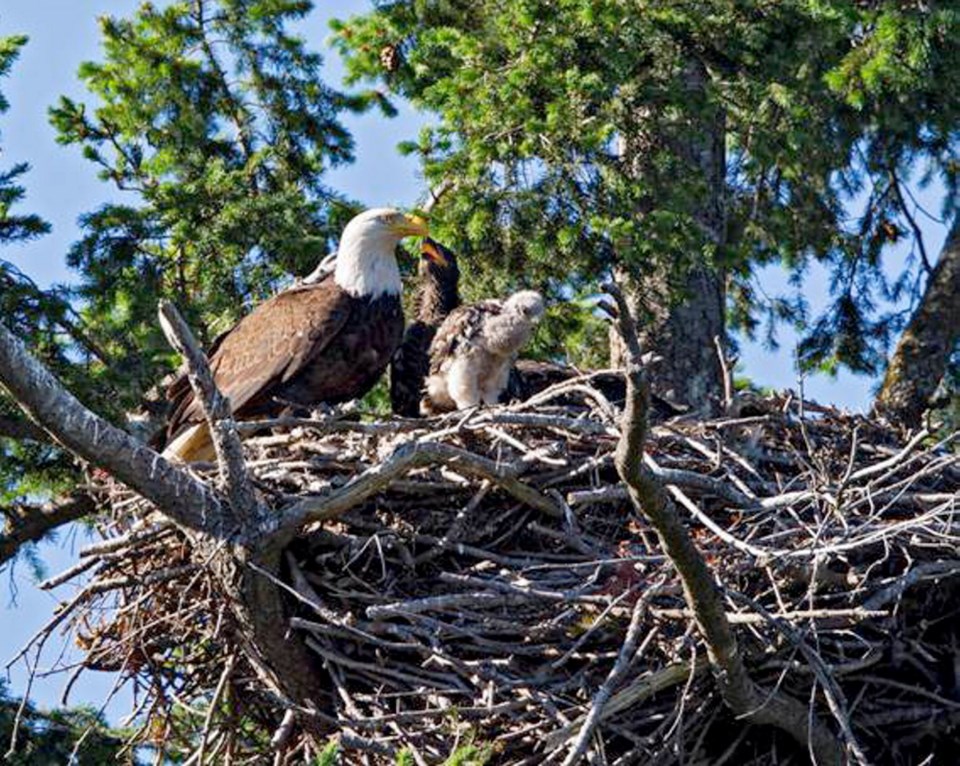Wildlife biologists and birders are bursting with theories about how a family of eagles nesting in Sidney began playing foster home to the chick of a red-tailed hawk.
The hawk chick, about a third the size and paler in colour than the three resident eagle chicks, has been living in the nest near Summerset Place on Roberts Bay since at least June 2, when it was first recorded.
“It’s a big surprise and quite unusual,” said Kerry Finley, a wildlife biologist who lives nearby.
“The [hawk chick] is very feisty and hungry, and obviously quite capable of defending itself,” Finley said. “It’s actually quite interesting watching the relationship between the hawk and its eagle siblings, who are quite tolerant of it.”
The chick has been identified as a red-tailed hawk by at least two wildlife biologists who have good knowledge of birds of prey and their chicks.
Theories of how it ended up in a family of eagles vary widely, from the grim and grisly to simple convenience and even dumb, wildlife luck.
One theory says the parent eagles took the chick’s hawk mother as prey. As the eagles tore apart her carcass, the egg rolled out to sit with the eagles’ own eggs until hatched.
Another says the hawk mother was flying when she suddenly had to drop the egg. The first convenient location she lighted upon was the eagle nest while the parents were away,
Finally, a theory that has gained some traction among bird-of-prey specialists is that the eagle parents took the chick as prey and carried it back to the nest as food for their own young.
But the chick was still alive. Once at the nest, the chick started to beg for food. Faced with an open mouth, the eagles’ parental response overrode their impulse to feed it to their babies.
“The hormonal instinct of the parents to feed it as a nestling kind of overrode the hormonal urge to kill it and feed it to the eaglets,” said David Bird, a McGill University wildlife biology professor with a specialty in birds of prey, now living near Sidney.
Bird said photos of the hawk chick have been sent to biologists around the world, who have estimated that it’s about 41Ú2 weeks old and likely close to fledging.
“But the big question is: ‘Will it actually fledge from the nest or will the eaglets start eyeing it and, if they get hungry, just kill it as a weaker bird?’ ” he said.
On the other hand, Bird said if the hawk successfully learns to fly and leave the nest, it has a reasonable shot at survival.
During its early days away from the nest, the hawk will venture farther and farther away. But it will return frequently and beg food from the parents, who will comply at least for a few weeks while the fledgling gains strength.
He said birds of prey don’t teach their young to hunt and kill; newly fledged birds mostly learn on their own.
So a red-tailed hawk, an opportunistic species that kills small mammals, such as mice and voles, or birds and snakes and even eats carrion, can learn just as well from bald eagles that largely eat fish, kill the occasional gull and eat a lot of carrion. “The odds are looking pretty good for that chick if it can successfully get out of that nest,” Bird said.
The story of the blended bird family is attracting much comment in the birding world.
But experts and bird enthusiasts say the phenomenon is not that unusual in nature. The brown-headed cowbird, found across North America, including Vancouver Island, deliberately lays eggs in the nests of other bird species, which then feed and rear the cowbird chick as their own. It’s the cowbird’s natural breeding strategy, said Ann Nightingale, of the Rocky Point Bird Observatory and past president of the Victoria Natural History Society.
“It’s just not that unprecedented to have one species raise another,” said Nightingale. “Still, how this particular chick got there is a mystery.”



